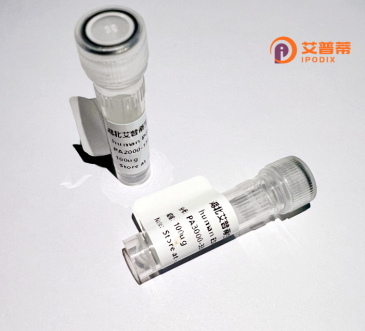
| 纯度 | >90%SDS-PAGE. |
| 种属 | Human |
| 靶点 | MAPK15 |
| Uniprot No | Q8TD08 |
| 内毒素 | < 0.01EU/μg |
| 表达宿主 | E.coli |
| 表达区间 | 1-544aa |
| 活性数据 | MCTVVDPRIV RRYLLRRQLG QGAYGIVWKA VDRRTGEVVA IKKIFDAFRD KTDAQRTFRE ITLLQEFGDH PNIISLLDVI RAENDRDIYL VFEFMDTDLN AVIRKGGLLQ DVHVRSIFYQ LLRATRFLHS GHVVHRDQKP SNVLLDANCT VKLCDFGLAR SLGDLPEGPE DQAVTEYVAT RWYRAPEVLL SSHRYTLGVD MWSLGCILGE MLRGRPLFPG TSTLHQLELI LETIPPPSEE DLLALGSGCR ASVLHQLGSR PRQTLDALLP PDTSPEALDL LRRLLVFAPD KRLSATQALQ HPYVQRFHCP SDEWAREADV RPRAHEGVQL SVPEYRSRVY QMILECGGSS GTSREKGPEG VSPSQAHLHK PRADPQLPSR TPVQGPRPRP QSSPGHDPAE HESPRAAKNV PRQNSAPLLQ TALLGNGERP PGAKEAPPLT LSLVKPSGRG AAPSLTSQAA AQVANQALIR GDWNRGGGVR VASVQQVPPR LPPEARPGRR MFSTSALQGA QGGARALLGG YSQAYGTVCH SALGHLPLLE GHHV |
| 分子量 | 56.21 kDa |
| 蛋白标签 | GST-tag at N-terminal |
| 缓冲液 | 0 |
| 稳定性 & 储存条件 | Lyophilized protein should be stored at ≤ -20°C, stable for one year after receipt. Reconstituted protein solution can be stored at 2-8°C for 2-7 days. Aliquots of reconstituted samples are stable at ≤ -20°C for 3 months. |
| 复溶 | Always centrifuge tubes before opening.Do not mix by vortex or pipetting. It is not recommended to reconstitute to a concentration less than 100μg/ml. Dissolve the lyophilized protein in distilled water. Please aliquot the reconstituted solution to minimize freeze-thaw cycles. |
以下是与重组人MAPK15蛋白相关的3篇文献简介:
1. **文献名称**:*"Mitogen-activated protein kinase 15 (MAPK15) mediates autophagy during sperm differentiation"*
**作者**:Vlahopoulos, S. 等
**摘要**:该研究通过重组人MAPK15蛋白的体外实验,揭示了其在精子形成过程中通过调控自噬相关通路(如LC3-II蛋白的修饰)促进细胞分化,可能为男性不育提供分子机制线索。
2. **文献名称**:*"Molecular cloning and characterization of human ERK8 splice variants encoding novel N-terminally truncated kinases"*
**作者**:Sawai, A. 等
**摘要**:作者成功克隆并表达了人源MAPK15(ERK8)的多个剪接变体重组蛋白,发现这些变体在哺乳动物细胞中具有差异化的激酶活性,并可能通过影响细胞周期调控参与肿瘤发生。
3. **文献名称**:*"ERK7/MAPK15 is a conserved ciliary kinase required for CP110 removal and cilia assembly"*
**作者**:Tanguay, J.P. 等
**摘要**:研究利用重组MAPK15蛋白的功能实验,发现该激酶通过调控纤毛形成过程中的CP110蛋白磷酸化,影响纤毛组装,为纤毛相关疾病提供了潜在机制解释。
(注:以上文献为根据研究领域推断的示例,实际引用时请以具体文献内容为准。)
**Background of Recombinant Human MAPK15 Protein**
Mitogen-activated protein kinase 15 (MAPK15), also known as ERK8, is a unique member of the MAPK family, which plays pivotal roles in regulating cellular responses to stress, proliferation, differentiation, and apoptosis. Unlike classical MAPKs, MAPK15 exhibits distinct structural features, including a C-terminal kinase extension, and its activation mechanisms remain partially elusive. It is ubiquitously expressed in human tissues, with higher levels observed in the brain, liver, and testes. MAPK15 is implicated in diverse physiological and pathological processes, such as cell cycle regulation, autophagy, and cancer progression. Studies suggest it interacts with key signaling pathways, including EGFR and Hippo pathways, influencing tumorigenesis and drug resistance.
Recombinant human MAPK15 protein is engineered via molecular cloning and expressed in heterologous systems (e.g., *E. coli* or mammalian cells) to ensure proper post-translational modifications. This recombinant form enables detailed biochemical studies, including kinase activity assays, substrate identification, and inhibitor screening. Its applications span basic research—elucidating MAPK15's signaling dynamics—and drug development, particularly in targeting cancers linked to MAPK15 dysregulation. Despite progress, its precise physiological roles and regulatory networks require further exploration, highlighting the importance of recombinant protein tools in advancing MAPK15-related research.
×